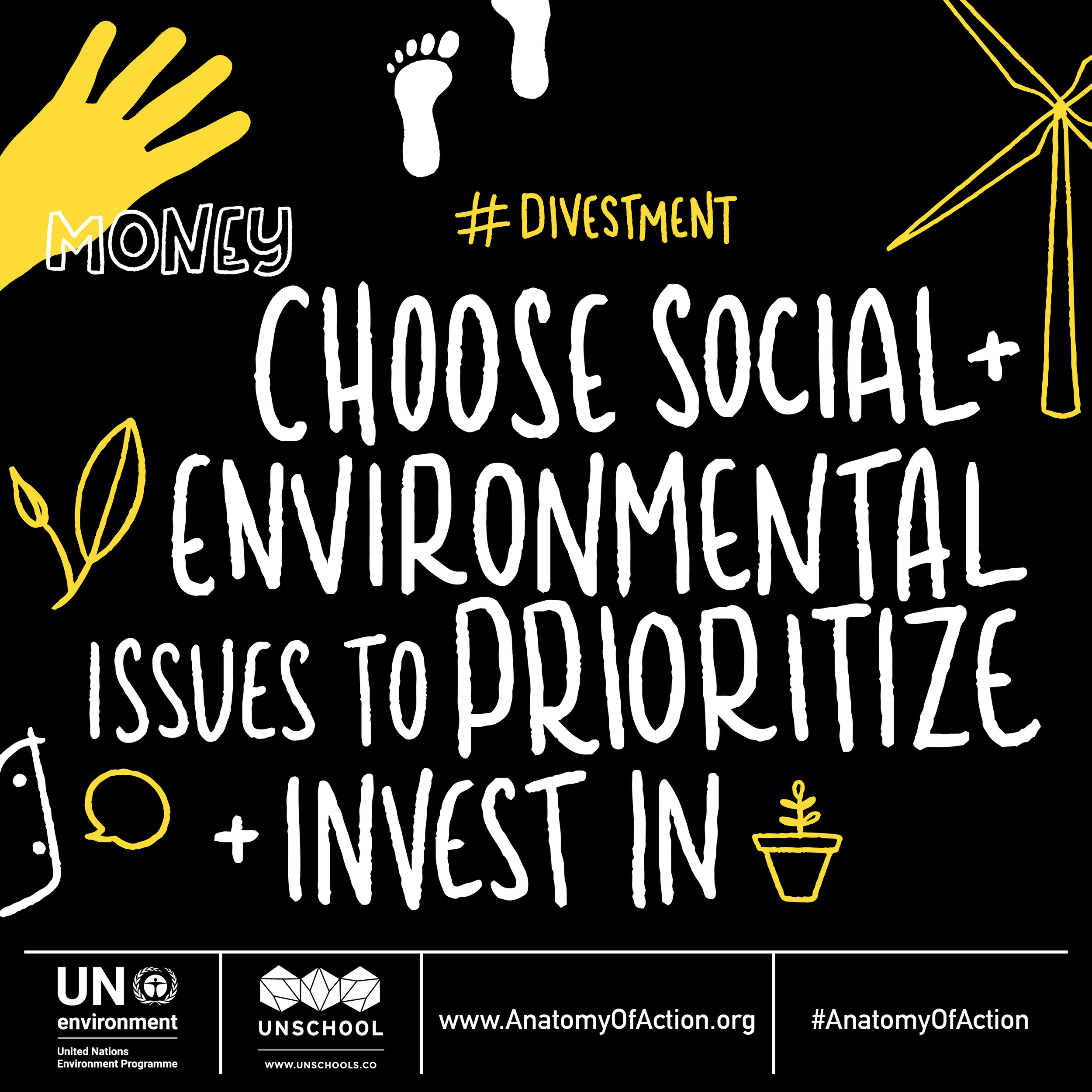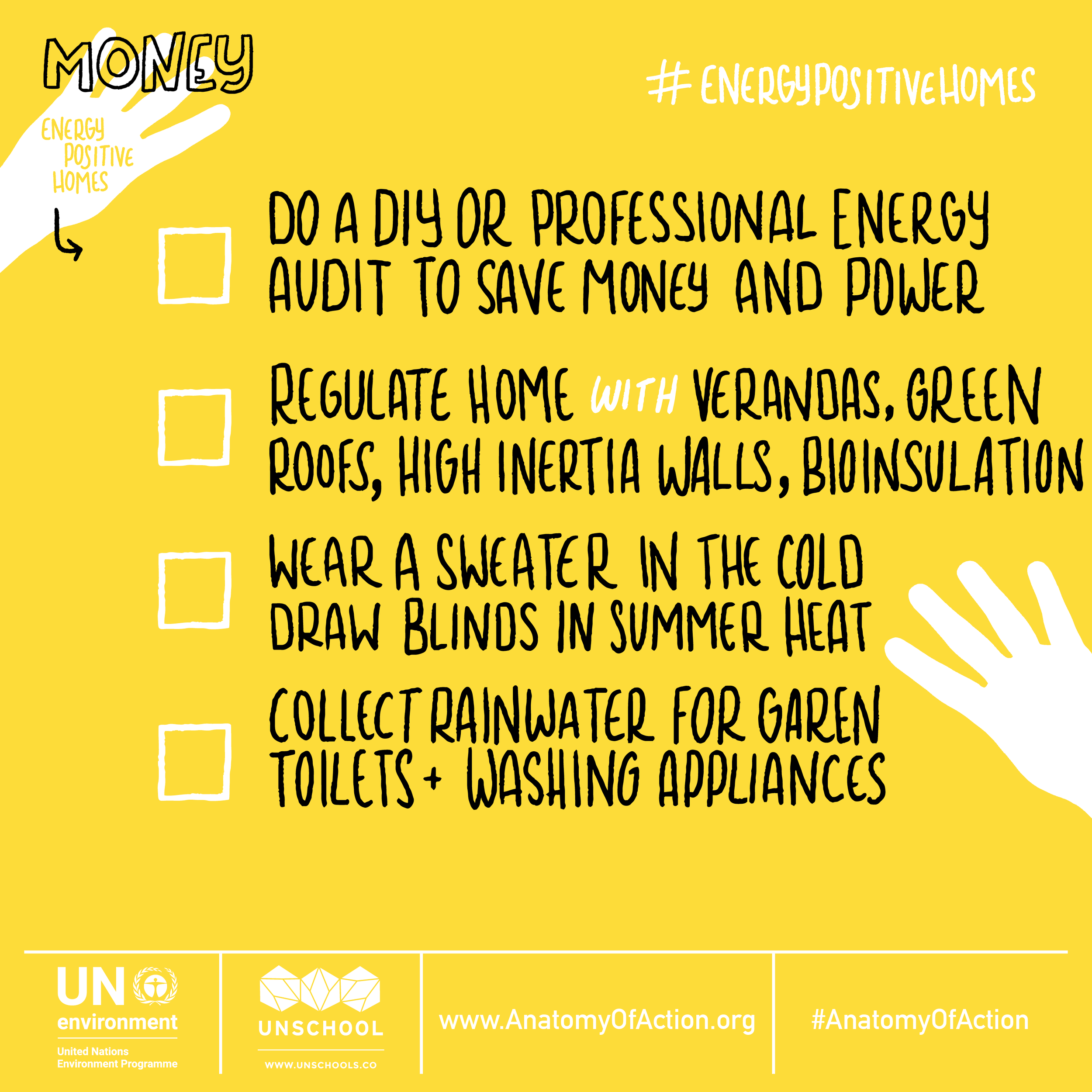Activist Anna Lappé has famously said, “Every time you spend money, you’re casting a vote for the kind of world you want,” and no matter how complex economic systems and personal finances can be, our individual impacts do really does boil down to that one simple sentence.
Like it or not, money makes the world go ‘round, as it is the core component to basically all of life’s functionality. Security, basic needs, pleasure, movement, hopes, dreams, relationships — money dynamically infiltrates every aspect of our being and influences the quality of our lives. But just because modern society ingrains social pressure to accumulate more and more money, does not mean that we have to be unethical about how we use it. Indeed, we can use money to powerfully influence the future so that it works better for us all, or blindly reinforce aspects of society that need to be changed. The power and influence of every dollar and cent spent is why Money is the fourth area of focus in the Anatomy of Action.
Action 1: Ethical Investment
If you’re not investing responsibly, you’re investing irresponsibly. Everything we buy has an impact on people and the world around us in general, so when you are thinking about purchasing what you need and want, consider your real needs and what types of goods and services you want to see more of in the future. You have the power to choose what your money supports (and what not to support). This goes for goods and services AND investments in stocks and bonds. The power behind this truth is becoming increasingly evident, as the global Socially Responsible Investing (SRI) market is now worth nearly $23 trillion, and there are more than 300 sustainable investment-related policy tools and market-led initiatives, in which more than half of them have been created in the last few years. Similarly, according to this report from the US SIF: The Forum for Sustainable and Responsible Investment, “High net worth individuals are increasingly influencing SRI issues including climate change, diversity, human rights, weapons and political spending with $3 trillion in sustainable assets.”
Investing in the future is also about the companies you invest in when you buy something. Financial planning that considers your sustainability impacts and available ethically- motivated options can support your family and your community, as well as the planet at large. In 2018, for example, more than half of impact investors reported tracking their impact performance against the SDGs, which are all about the future greater good for all. Choosing to invest how every big or small amounts of money you have in more locally produced goods and services can have positive economic outcomes for your community as well, as it injects cash directly into your community.
#EthicalInvesting Everyday Actions:
Spend time and money on things that have positive impacts
Decide on your priority social and environmental issues and invest accordingly
Ask your bank about their sustainable investment policy and if they don't have one then swap banks if you can
Speak up and voice your preference for sustainable investments - look at long-term drivers that affect company performance
Invest in goods and services produced in sustainable ways
Never invest in products made from endangered wildlife
Invest in a diversified portfolio (don’t put all your eggs in one basket)
Put savings in responsible stocks, investments, including pensions and banks
Pay taxes to help build your community
Advance your family finance skills and financial management to avoid going into or starting to get out of debt
Action 2: Divestment
Intentionally investing isn’t the only way to send a message to the market; divestment is another powerful way to share how important sustainability is to you. Divestment happens when people move money away from industries and commercial activities that are unsustainable and instead choose investments, banks, energy providers, and other companies and services that are supporting renewable options, sustainable consumption and production, and development of more sustainable and ethical industries.
Most notably, fossil fuel divestment (inspired by the anti-apartheid movement in South Africa) is on the rise, and as of early 2018, more than 700 organizations from more than 76 countries with over $5.5tn (trillion!) of assets have committed to divesting in fossil-fuel companies and instead will invest in climate solutions.
The needs are clear, with the planet and human health suffering in unprecedented ways — like the fact that unpaid health bills from air pollution due to fossil fuels accounted for US$5.3tn in 2015 (!) — that’s more than global health spending (and by the way, we talk a lot about the impacts of fossil fuels in our Move journal article). The UN has issued multiple warnings and clearly stated in the Intergovernmental Panel on Climate Change’s 2018 report: “Unless humans transform the economy in such a way that has no documented historic precedent, the earth will experience worsening food shortages and wildfires, and a mass die-off of coral reefs as soon as 2040.”
While this cautioning is scary to consider, let a problem-loving approach override the fear, knowing that we all do have individual agency that, when activated for positive sustainable change, adds up to bigger collective shifts.
Make no mistake, as more and more people do this, it sends strong messages to companies to consider their business models and actions to support renewable energy, sustainable technologies, and more responsible products. When it comes to fossil fuels, just 100 companies (all within the oil and gas industry) are responsible for 71% of global carbon emissions — so aiming at divesting from any of these 100 companies can definitely have a large impact. And in doing so, there will be a ripple effect in “creating a new wave of the moral entrepreneur or norm entrepreneur, concerned with labelling a particular behaviour (carbon pollution) as morally reprehensible, and, by so doing, shifting attitudes about climate change mitigation.”
#Divestment Everyday Actions
Move your money; ask your bank how they invest your money. If it is in fossil fuels or other unsustainable industries (such as weapons, tobacco etc) - then move banks, and tell your bank why
If you have a retirement fund, you could be inadvertently investing in unsustainable industries. If so, ask your fund manager to move to a more responsible fund
For investments in stocks, bonds, funds you can avoid investing in companies you believe are harmful and choose to invest in those that support more sustainable efforts
Swap your energy provider to a non fossil fuel based provider or support collective or community run wind and solar farms
Divest from fossil fuel or unethical companies
Action 3: Energy Positive Homes
One of the areas we spent a lot of our money on is our living space. Our homes are a massive contributor to our personal ecological footprint, from rent to energy services, homes eat up a chunk of our personal budgets so they can greatly impact our anatomy of action. In the US, homes and commercial buildings consume 40% of the energy used throughout the country (and 10-20% of the average American’s energy bill expenditure might be wasted due to drafts, leaks, and outdated systems) — this, coupled with the fact that energy use per m2 in buildings needs to be reduced by 30% by 2030 to be in line with the Paris Agreement and follow the Sustainable Development Scenario, demonstrates what kind of opportunity lies in energy positive behaviors.
Energy efficiency, renewables, appliances, and behaviors at home not only promote climate change mitigation, but also save money, generate utility savings over time, and increase the value of property; in fact, the World Green Business Council shares that “energy-efficient housing is more affordable over its lifetime than non-efficient buildings.” Renewable energy offerings are becoming more prevalent and therefore quite affordable; for example, US-based power company PG&E offers 100% renewable energy at the cost of USD $4.36 /month. Making your home more sustainable can also help support the local economy and can increase the level of comfort by enhancing the quality of your life.
Swapping to a renewable energy supply moves us toward sustainable energy, but most of the savings can be attained through small technical interventions in the home, ensuring it is well insulated against hot and cold weather. And, as the US EPA has reported, “In addition to energy efficiency techniques, other emissions reduction opportunities for the home include actions such as: Making water and wastewater systems more energy-efficient; reducing solid waste sent to landfills; capturing and using methane produced in current landfills; reducing leakage from refrigeration equipment; and using refrigerants with lower global warming potentials.
#EnergyPositiveHomes Everyday Actions:
Find ways to save on your energy bill via do-it-yourself or professional audit of energy used/saved/lost in your home and make simple changes
Regulate home temperatures better by adding verandas, green roofs, high inertia walls, and bio-based insulation
Adapt to the season: stay comfortable and save energy (wear a sweater, draw blinds in summer)
Take simple steps: seal windows and doorsteps, avoid thermic bridges, install double glass glazing, use LED bulbs, invest in high inertia radiators
Change habits: open the curtains for natural light; close shades in hot climates; cover pans when boiling, spend less time in shower, compost organics
Produce your own energy: install a small scale solar installation to power your home
Collect rainwater and reuse it for gardening, toilets, and washing machines
Use appliances as intended, consider buying more energy and water efficient appliances when replaced
Compare energy providers available and choose a more sustainable one (renewable energy)
There are no simple solutions to complex problems, and the global economic issues we face are indeed complex and vast. While the global environmental issues may be big and sometimes overwhelming, they are the outcomes of many individual actions. So, the choices we each make as individuals, as workers, and as members of societies have the potential to reinforce undesirable actions or to create the opportunity for new, more sustainable solutions.
The actions outlined in the Anatomy of Action are are some of the top-level actions any individual can do to help support the global shift toward a more sustainable and regenerative future. No matter who you are, every action you take has an impact, so by taking these more considered actions, you can contribute to a global movement towards activating the SDG’s and designing a circular economy that gives back more than it takes. There are many other things you can do; this list is by no means an exhaustive account of all the aspects of our lives, but all the actions in the Anatomy of Action offers a starter list that any individual, anywhere can take action on to help make a positive future for all of us!


















